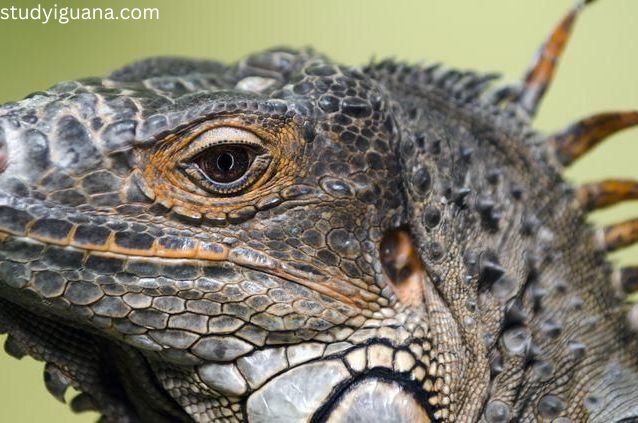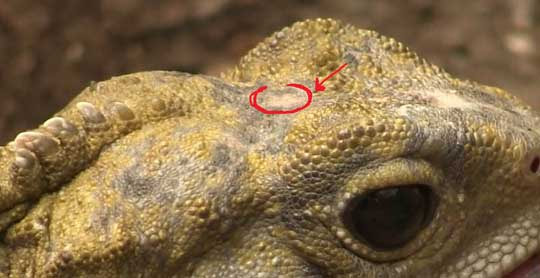Do iguanas have three eyes? Iguanas are fascinating creatures that are often kept as pets due to their unique appearance and docile nature. They are known for their scaly skin, sharp claws, and long tails. However, one of the most curious aspects of these reptiles is their eyes. While most iguanas have two eyes like most other vertebrates, there is a persistent myth that iguanas have a third eye. This myth has circulated for many years, causing confusion and fascination among iguana enthusiasts and casual observers alike. In this article, we will explore whether iguanas do indeed have three eyes or if it is simply a myth.
Iguanas are a group of large, herbivorous lizards native to Central and South America. They are popular pets due to their unique appearance and docile demeanor. However, there is a myth surrounding iguanas that they have a third eye on the top of their heads. This “third eye” is said to give iguanas supernatural abilities and mystical powers. In this article, we will explore the truth about iguanas’ eyes and the origins of this myth.
The Truth About Iguanas’ Eyes
Iguanas have two regular eyes, just like most other animals. Their eyes are located on the sides of their heads and are protected by a clear scale called a spectacle. The anatomy of iguanas’ eyes, often raising the question ‘do iguanas have three eyes,’ is similar to other reptiles and includes a cornea, lens, iris, and retina.

Anatomy of iguanas’ eyes
The anatomy of iguanas’ eyes is similar to other reptiles. Like most other animals, iguanas have two eyes that are located on the sides of their heads. Their eyes are protected by a clear scale called a spectacle, which helps to keep their eyes moist and free from debris.
The eye of an iguana includes several important components. These include the cornea, which is the clear outermost layer of the eye that helps to focus incoming light; the lens, which helps to further focus the incoming light onto the retina; the iris, which controls the size of the pupil and regulates the amount of light that enters the eye; and the retina, which is the layer of cells that detect light and transmit visual information to the brain.
Visual abilities of iguanas
Iguanas’ visual abilities are well adapted to their natural habitat. They are able to see a wide range of colors and can distinguish between different shades of blue and green. They also have excellent motion detection abilities, which is helpful for detecting predators and prey.
In the wild, iguanas use their eyes to detect potential predators and avoid danger. They are also able to find food sources, such as leaves and fruit, with their visual senses.
How iguanas use their eyes in the wild
Do iguanas have three eyes? In the wild, iguanas use their eyes to detect potential predators and avoid danger. They are also able to find food sources, such as leaves and fruit, with their visual senses.
Common eye problems in pet iguanas and how to prevent them
However, pet iguanas may experience common eye problems, such as conjunctivitis, corneal ulcers, and vitamin A deficiency. It is important for pet owners to provide proper care to prevent these issues from occurring. This includes regular checkups with a reptile veterinarian, a balanced diet with appropriate supplements, and proper lighting and humidity levels in their enclosure
The Origins of the Third Eye Myth
Do iguanas have three eyes? The myth of iguanas having a third eye is believed to have originated from the presence of a small, raised area of scales on the top of their heads. This area, known as the parietal eye or pineal gland, is actually a sensory organ that helps iguanas to detect changes in light and dark cycles.

The parietal eye and its function
The parietal eye is located in the center of the iguana’s head and is covered by a translucent scale that allows light to enter. This allows the organ to detect light and dark cycles, which is important for regulating the iguana’s circadian rhythm and biological functions.
Cultural and religious beliefs about the third eye
Do iguanas have three eyes? The parietal eye has been the subject of many myths and legends throughout history. In some cultures, it was believed to give iguanas supernatural powers, such as the ability to see into the future or to ward off evil spirits. “In other cultures, the belief that ‘do iguanas have three eyes’ relates to the parietal eye as a symbol of spiritual enlightenment or transcendence.”
While the parietal eye is an interesting and unique feature of iguanas, it does not give them any supernatural powers or mystical abilities. Rather, it is simply an important part of their anatomy that helps them to regulate their biological functions in response to changes in light and dark cycles.
Caring for Pet Iguanas
Caring for pet iguanas requires a significant amount of time and effort. Iguanas are sensitive animals that require a specific diet, adequate lighting and heat, and regular veterinary care to stay healthy. Here are some tips for caring for pet iguanas:
Diet
Iguanas are herbivores and require a diet that is high in fiber and low in protein. They should be fed a variety of greens, vegetables, and fruits, such as collard greens, dandelion greens, squash, and strawberries. It is important to avoid feeding them animal-based foods or high-protein foods, as these can cause health issues.
Enclosure
Pet iguanas need a large enclosure that provides plenty of space to move around. The enclosure should be lined with a substrate that is safe for the iguana to walk on, such as reptile carpet or paper towels. Iguanas also require a basking area, as well as a cooler area, to regulate their body temperature.
Lighting and Heat
Iguanas require access to UVB lighting and heat sources to stay healthy. UVB lighting helps them to synthesize vitamin D, which is important for calcium absorption and bone health. Heat sources, such as basking lamps and heat pads, help to regulate their body temperature and digestion.
Humidity
Iguanas require a humid environment to prevent dehydration and skin problems. Their enclosure should be misted with water regularly, and a humidifier can also be used to maintain adequate humidity levels.
Veterinary Care
Iguanas require regular veterinary checkups to monitor their health and prevent potential health issues. They should be examined by a reptile veterinarian at least once a year, and more frequently if they show signs of illness or injury.
Caring for pet iguanas can be challenging, but with the proper care and attention, they can make rewarding and fascinating pets.
Misconceptions About Iguanas
Iguanas are fascinating and unique creatures, but there are many misconceptions about them, including the question ‘do iguanas have three eyes,’ that can lead to improper care and handling. Here are some of the most common misconceptions about iguanas:
Iguanas are easy to care for
Many people assume that iguanas are low-maintenance pets, but this is far from the truth. Iguanas require a significant amount of time, effort, and specialized care to stay healthy.
Iguanas are friendly and cuddly
While iguanas can be docile and affectionate with their owners, they are not naturally social animals and may become aggressive or defensive if they feel threatened or stressed.
Iguanas are great pets for children
Iguanas are not ideal pets for children, as they require specialized care and handling. Children may also be at risk of injury from an iguana’s sharp claws and teeth.
Iguanas can thrive on a diet of lettuce
Lettuce is low in nutrients and does not provide the necessary vitamins and minerals that iguanas need to stay healthy. A varied and balanced diet of greens, vegetables, and fruits is essential for their well-being.
Iguanas can live in small enclosures
Iguanas require a large enclosure that provides plenty of space to move around. A small enclosure can lead to stress, illness, and behavioral problems.
It is important to educate yourself about iguanas and their specific care requirements before deciding to bring one into your home. By understanding the truth about iguanas and avoiding common misconceptions, you can provide them with the best possible care and ensure their health and happiness.
Conclusion
In conclusion, do iguanas have three eyes is a common myth, but iguanas do not have a third eye, despite the long-standing belief that has been perpetuated for centuries. Instead, they have two well-developed eyes that are adapted to their arboreal lifestyle and are protected by a nictitating membrane. While the idea of a third eye may seem intriguing, it is important to base our understanding of animals on scientific evidence and not myths or legends.
FAQS
Do iguanas really have three eyes?
No, do iguanas have three eyes is a misconception. Iguanas have two eyes, like most other vertebrates.
Why is there a myth about iguanas having a third eye?
The myth likely originated from the presence of a small, scale-like structure on the top of some iguanas’ heads called the parietal eye. This structure is not a functional eye, but it may have contributed to the belief that iguanas have three eyes.
What is the pineal gland, and how does it relate to the third eye myth?
The pineal gland is a small, pea-sized gland in the brain that is responsible for producing and regulating various hormones, including melatonin. Some people believe that the pineal gland is a ‘third eye’ capable of spiritual or mystical experiences, leading to the question, ‘do iguanas have three eyes,’ but there is no scientific evidence to support this idea.
Can iguanas see colors?
Yes, iguanas are able to see colors, although their color vision may not be as vibrant as that of humans or some other animals.
What are some common misconceptions about iguana care?
Some common misconceptions about iguana care include that they only need to be fed lettuce, that they can live in small enclosures, and that they don’t require UVB lighting. In reality, iguanas have specific dietary and environmental needs that must be met in order for them to thrive.
How can I ensure that my pet iguana stays healthy and happy?
To ensure that your pet iguana stays healthy and happy, you should provide it with a spacious enclosure, a varied diet that includes both plant and animal matter, UVB lighting, and regular veterinary check-ups.
What should I do if I suspect that my iguana is sick or injured?
If you suspect that your iguana is sick or injured, you should take it to a qualified veterinarian who has experience with reptiles. Signs of illness or injury in iguanas may include lethargy, loss of appetite, diarrhea, difficulty breathing, or changes in behavior.
Are iguanas good pets for beginners?
Iguanas can be challenging pets for beginners due to their specific care requirements and potentially aggressive behavior. It is important to research and understand the needs of iguanas before deciding to get one as a pet.
How long do iguanas typically live?
Iguanas can live for up to 20 years or more in captivity, provided they receive proper care.
What should I do if I encounter an iguana in the wild?
If you encounter an iguana in the wild, it is best to observe it from a safe distance and avoid disturbing or handling it. Iguanas may bite or scratch if they feel threatened, and they may also carry bacteria that can cause infections in humans.
Additional readings:
